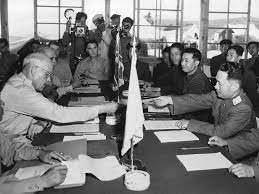As the Russia-Ukraine war marks one year and enter into the second year, an end to the war seems a long way off. And some raise the possibility that it might be following how the Korean War (1950-53) ended in an armistice.
The Korean War, which began in 1950, ended in a ceasefire in 1953 with the signing of an armistice agreement. However, a peace treaty was never signed, and the two Koreas remain technically at war. The reasons for this include stalemate, political tensions, disagreements over prisoners of war, and North Korea's refusal to recognize South Korea. The armistice agreement resulted in the division of Korea, ongoing military presence in the region, and periodic military skirmishes. Recent efforts to negotiate a peace settlement between North and South Korea offer hope for resolving the conflict, but the prospects for peace remain uncertain.
Can the world find some lessons from what happened on the Korean Peninsula more than half a century ago?
Still Technically at War: How the Korean War Ended in 1953... A Lesson for Ukraine?
The Korean War, which began in 1950, resulted in a ceasefire in 1953, but a peace treaty was never signed. As a result, technically, the two Koreas are still at war. In this article, we’ll explore how the Korean War ended and why it still technically continues.
The Korean War: A Brief Overview
The Korean War began on June 25, 1950, when North Korean troops invaded South Korea. The United Nations, with the United States as the main participant, intervened on behalf of South Korea. China intervened on behalf of North Korea, and the Soviet Union provided military assistance to North Korea.
The war continued for three years, resulting in millions of civilian and military casualties. The war devastated the Korean Peninsula, leaving it divided between North and South.
The Armistice Agreement of 1953
On July 27, 1953, an armistice agreement was signed between the United Nations Command, the Korean People’s Army, and the Chinese People’s Volunteer Army. The agreement established a ceasefire line and created a demilitarized zone (DMZ) that runs roughly along the 38th parallel.
The armistice agreement effectively ended the fighting and established a temporary peace, but it did not officially end the war. The agreement called for a political conference to be held within three months to negotiate a peace settlement, but this never happened.
Why Wasn't a Peace Treaty Signed?
There were several reasons why a peace treaty was never signed to end the Korean War:
- Stalemate: Neither side was able to achieve a decisive victory, and the war ended in a stalemate.
- Political tensions: The political tensions between the two Koreas and their allies, the United States and China, made it difficult to reach a peace settlement.
- Prisoners of war: The two sides disagreed on the repatriation of prisoners of war, which led to a prolonged negotiation process.
- Status of South Korea: North Korea did not recognize South Korea as a legitimate state and demanded that the United States withdraw its troops from the Korean Peninsula.
As a result, the armistice agreement remained in effect, and the two Koreas are still technically at war.
The Consequences of the Armistice
- Division of Korea: The agreement solidified the division of Korea into two separate states, with the DMZ serving as a physical and political barrier.
- Military presence: The United States maintains a military presence in South Korea to this day, as a result of the armistice agreement.
- Ongoing tension: The lack of a peace treaty has led to ongoing tension and periodic military skirmishes between North and South Korea.
